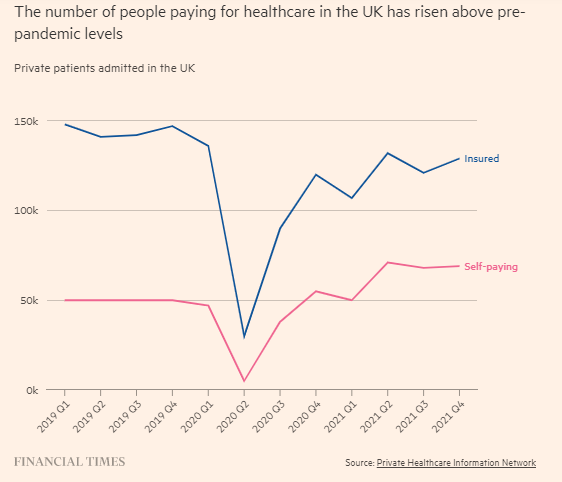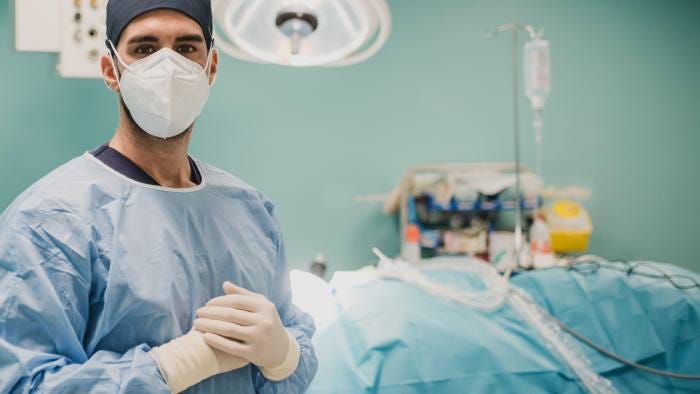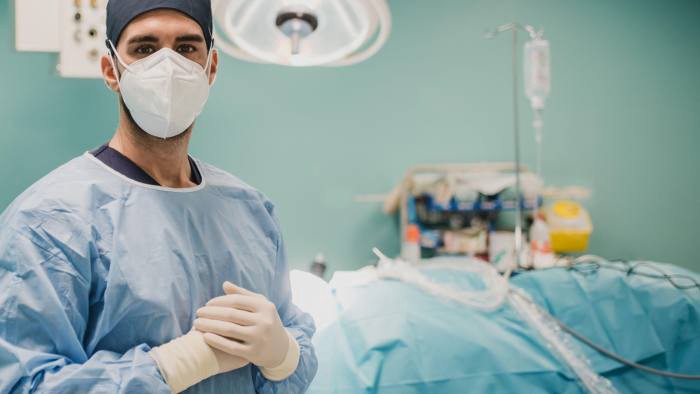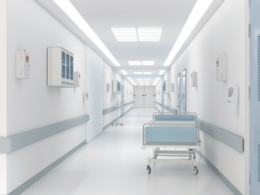Personally funded treatments increase by 39% across UK in past two years as waiting lists spiral
Even among UK households earning less than £40,000 a year the number willing to fund their own procedures has risen by 54%, or 1.7mn people, analysis shows
Financial Times
Sarah Provan and Sarah Neville in London
AUGUST 28 2022
Gabriel Trujillo/Alamy
Site editor:
Joaquim Cardoso MSc.
Health Transformation Journal
September 4, 2022
Demand for private healthcare is soaring in the UK even while a sharp increase in living costs hits customers’ pockets, as patients despair of record NHS waiting lists, data show.
Self-pay admissions — where people choose to fund their own healthcare rather than use private health insurance — rose 39 per cent across the UK in the two years to the end of 2021, according to the independent Private Healthcare Information Network, an organisation that tracks treatment data.
Demand rose by 90 per cent in Wales and 84 per cent in Scotland.
In England, the increase in self-funded treatments was highest in the East Midlands, at 75 per cent, compared with 20 per cent in London, where demand was already the highest nationally.
Self-pay admissions — where people choose to fund their own healthcare rather than use private health insurance — rose 39 per cent across the UK in the two years to the end of 2021
Demand rose by 90 per cent in Wales and 84 per cent in Scotland.
The sharp increase in the number of people opting for self-pay procedures reflects the public’s growing frustration with the health service where, according to NHS England, waiting lists are “significantly higher” than during the pre-Covid era.
The sharp increase in the number of people opting for self-pay procedures reflects the public’s growing frustration with the health service …
A record 6.73mn people were waiting for consultant-led elective care under the NHS in England, according to June figures, with 2.54mn in the queue for longer than 18 weeks. NHS England said the median wait for treatment was 13.3 weeks.
A record 6.73mn people were waiting for consultant-led elective care under the NHS in England, according to June figures, with 2.54mn in the queue for longer than 18 weeks
David Hare, chief executive of the Independent Healthcare Providers Network, identified “a very strong correlation between growing NHS waiting lists and those patients that are choosing to self pay”.
About half of Britons would consider private treatment, polling by the organisation showed. In almost half of cases this was because people were having difficulty accessing NHS care.
Spire Healthcare, which as the only London-listed private healthcare group is seen as a good barometer for the £1.1bn self-pay market, said personally funded care accounted for 29 per cent of its business.

The group added that 58 per cent of its target patients are more likely to consider using a private hospital as a result of growing NHS waiting lists.
“Attitudes are changing,” said Spire chief executive Justin Ash.
Far from a shortlived boom, he believes the upsurge of interest in self-pay marks a “fundamental shift”, describing the demand for care as “strong [and] unprecedented”.
Far from a shortlived boom, he believes the upsurge of interest in self-pay marks a “fundamental shift”, describing the demand for care as “strong [and] unprecedented”.

The preference for private healthcare is coming from a broader income distribution than in the past, Hare noted.
Even among households earning less than £40,000 a year the number willing to fund their own procedures has risen by 54 per cent, or 1.7mn people, compared with two years earlier, according to Spire’s analysis.
Cataract procedures cost about £2,000 on average, while an MRI scan is about £350, Hare noted. “Often the public is surprised by how affordable private healthcare can be,” he said.
“People prioritise their healthcare above most other things.”
Analysts agree that a fundamental change is taking place.
“The core demographics of pay are shifting,” said Liz Heath, a specialist in self-pay care at consultancy LaingBuisson, adding that financial services groups had made it easier for patients to access products that spread the cost of treatment.
Many people who did not have holidays during pandemic lockdowns had more disposable cash, she noted.
Overall, the most popular procedure for people to pay for out of their own pockets is cataract surgery, according to PHIN.
The age group most commonly paying for healthcare treatment — including cataracts and joint replacements — is over 55.
Overall, the most popular procedure for people to pay for out of their own pockets is cataract surgery, according to PHIN.
The age group most commonly paying for healthcare treatment — including cataracts and joint replacements — is over 55.
Originally published at https://www.ft.com on August 28, 2022.












